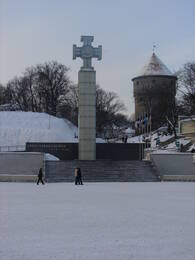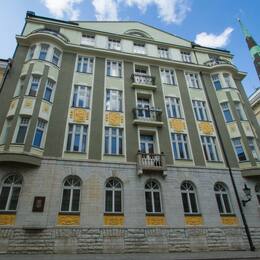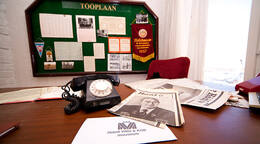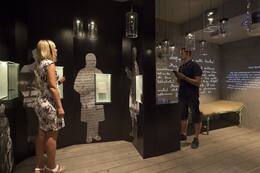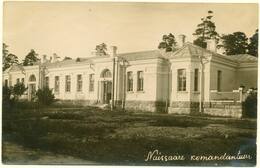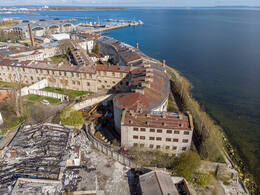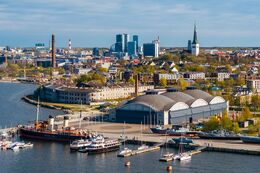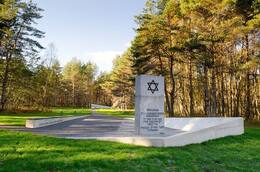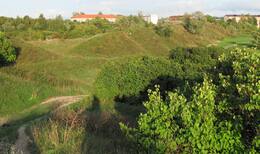Life in Estonia during the Soviet occupation
Estonia's Victims of Communism Memorial
The memorial is located in Maarjamäe, Tallinn. Estonia lost every fifth person of its population during the World War II and as a consequence of the terror imposed by the occupying regime.
The Memorial to the Victims of Communism is dedicated to the more than 75,000 Estonians murdered, imprisoned or deported by the Soviet authorities.
It consists of two parts: 'Journey', with name plaques of the victims; and a symbolical 'Home Garden', with informative texts and stone tablets marking sites of terror
Estonian War Museum - General Laidoner Museum
This museum, which has been housed in the mid-19th century historicist Viimsi Manor since 2001, conducts research into and both preserves and displays Estonian military history. Its predecessors were the Estonian War of Liberation Museum (founded on 19 January 1919) and a museum dedicated to General Laidoner established at the manor by decree of Viimsi Municipal Government in 1993. During the Soviet occupation, the manor was used by a naval intelligence unit: after the withdrawal of the Soviet Army, the building was in a dire state. The museum was founded by decree of Minister of Defence Jüri Luik on 26 February 2001. Since then, the museum has operated under the jurisdiction of the Ministry of Defence. Its main exhibition showcases wars fought in Estonia and abroad in which Estonians have participated. Part of the exhibition is dedicated to Commander-in-Chief Johan Laidoner, who owned the manor from 1923-1940. The military equipment hangar near the main building displays a variety of artillery pieces and vehicles.
KGB Prison Cells
This museum is located in the cellar of the former NKVD and KGB headquarters in the centre of Tallinn.
The building at 1 Pagari Street was home to one of the most infamous and feared pre-trial detention centres of the Soviet era, where many Estonian politicians, state officials, intellectuals, War of Independence veterans and even commoners were tortured and sentenced to death or prison. The unmodified cells are the epitome of the Red Terror and are now open to visitors. The museum consists of two corridors, six prison cells and one solitary confinement cell. The main exhibition, entitled ‘History of the KGB House’, recalls the atrocities committed there.
This address has had an interesting past. The residential building constructed here in 1912 was the headquarters of the Provisional Government of Estonia and the military high command during the War of Independence. Then, until 1940, the building housed the Ministry of War of the Republic of Estonia. In March 1991 the building became the head office of the Estonian Police. Today, 1 Pagari Street has regained its former residential use.
Hotel Viru and KGB museum
Hotel Viru in Tallinn was built in 1972. The hotel for foreigners also had to suit to the national security body, i.e KGB. The museum tells the story of more than just one hotel and the KGB. It is a treasure trove of stories of two different worlds - one which existed mostly on paper, of happy Soviet citizens living in friendship and never wanting for anything, led by a wise, all-powerful group of men in a place where there were never any accidents or catastrophes; and the other real world, which was a very different and a much tougher place to live in.
Please book in advance to visit the museum.
Vabamu Museum of Occupations and Freedom
Vabamu museum is situated in the centre of Tallinn.
A private museum, it opened in 2003 to showcase Estonian history from 1940-1991. The museum recalls stories from recent history highlighting both the value and fragility of freedom.
The main exhibition and the films shown at the museum provide an overview of the Soviet occupation, oppression, national resistance and the Singing Revolution.
The main exhibition, ‘Freedom Has No Limits’, is divided into five topics: ‘Inhumanity’, ‘In Exile’, ‘Soviet Estonia’, ‘Restoration’ and ‘Freedom’. Museum visitors can take an audio tour (in Estonian, Russian, English, Finnish, German, French or Spanish) to guide them on this immersive and retrospective journey through history. There are also activities for children, offering an unforgettable experience for the whole family.
Naissaar
This island, which covers 19 square kilometres in the Bay of Tallinn, was acquired by the Imperial Russian Navy in 1912, forcing out the locals. The navy built ports, railways and coast batteries as part of Peter the Great's Naval Fortress on the island. During World War I and the War of Independence, the island also held a prisoner-of-war camp. The newly independent Republic of Estonia retained the island as part of the established coastal defence system, but allowed the locals to return to it. During the Soviet occupation, the island was under the control of the military, who built a naval mine depot and factory there. The buildings and equipment left behind on Naissaar by the Soviet Army can still be partially explored today. The network of bunkers designed to form the naval fortress goes deep underground. Some of the bunkers and artillery mounts are still accessible. A full tour of the island can be taken in a day. The island used to be covered with a dense railway network connecting the military facilities. This is why the remaining tracks are a great trail guide for touring the island.
Naissaar is home to 40 kilometres of narrow gauge railways, the laying of which began in 1913 during the czarist era. The railway network was also partially used during the era of independence and during the Soviet occupation. Today a 2.4 kilometre segment of it has been restored. The Museum of Coastal Folk has various exhibitions on display for visitors to the island providing a more elaborate overview of the island's history. A military exhibition is on display in the Soviet-era career soldiers' living quarters in Männiku village, which showcases both the island's earlier and more recent military past. Naissaare lighthouse is hosting an exhibition called 'Naissaar on old postcards', which depicts the island during its heydays.
Patarei Naval Fortress
A former naval fortress located in the Kalamaja district of Tallinn.
Designed by military engineers Étienne-Louis Boullée and Claude-Nicolas Ledoux, Patarei was commissioned in 1829 by Russian Emperor Nicholas I. The complex was opened in 1840, but this did not mean that construction work was complete. The fortress underwent renovations: there were fears that the British and French would attack from the Baltic Sea after the outbreak of the Crimean War in 1853. This did indeed come to pass, but it did not escalate into large-scale warfare. Only a few shots were fired from Patarei. As a result of the adoption of explosive projectile, Patarei was decommissioned as a fortress in 1858 and was thereafter used as barracks. During the era of Estonia’s independence, Patarei was turned into a prison, which operated until 2002. It had also been used as a prison during the German and Soviet occupations. The atrocities committed there by those regimes made the place infamous among the population. The architecturally prominent building, which covers four hectares, is now home to an exhibition entitled ‘Communism is Prison’, which shines the spotlight on communist ideology, communist crimes and the history of the building. Renovations of this remarkable architectural wonder covering four hectares began in 2020. By 2026 Patarei shall be an integrated urban landscape complete with commercial space, living quarters and leisure options. The original prison interior and exercise yards shall be preserved in the eastern wing of the building. Already there's an exhibition on the communist ideology and atrocities and the history of the building covering close to 1200 square metres.
Seaplane Harbour
The Seaplane Harbour is situated on the water’s edge in the Kalamaja district of Tallinn.
It was commissioned during World War I by Russian Emperor Nicholas II as part of Peter the Great's Naval Fortress. The museum, based in the historic seaplane hangar, has around 200 original exhibits on display: the submarine Lembit, the 100-year-old icebreaker Suur Tõll, the seaplane Short 184, the oldest Estonian shipwreck, mines, cannons and more. Temporary exhibitions complement the main exhibition. The seaplane hangar is architecturally unique: its domed roof was one of the first thin concrete shell structures of its kind.
The museum’s programmes and materials for individual visits are fun and educational for adults and children alike.
Klooga Concentration Camp and Holocaust Memorial
This memorial to the victims of the Holocaust is situated not far from the small borough of Klooga.
The first monument was erected here in 1951, but it essentially praised the Soviet ideology and did little to commemorate the victims of the Holocaust. In 1994, the plaques on the monument were replaced with new ones at the request of the Jewish community in Estonia so as to do justice to the victims' ethnic roots. On the 50th anniversary of the mass murder perpetrated in Klooga, a monument to the Jews killed in Estonia from 1941-1944 was unveiled 100 metres from the first monument. In 2005, a third monument was unveiled commemorating the Jews who died or were killed in the concentration camp in Klooga.
The memorial was renovated in 2013 to tie the three monuments together, with the Estonian History Museum opening an outdoor exhibition here entitled ‘Klooga camp and the Holocaust’.
Klooga concentration camp was established by the German regime in September 1943. It was a forced-labour sub-camp of the Vaivara concentration camp complex in Estonia. On 19 September 1944, one of the largest mass murders in German-occupied Estonia was committed: all of the Jews at the camp (around 2000 in total) were killed as the Red Army approached.
Paldiski - Closed Soviet Town
The town of Paldiski (historically known as Rågervik) is located on the north coast of Estonia on the Pakri peninsula.
It has been an important port since the Great Northern War. In 1718, Russian Emperor Peter the Great ordered the construction of a fortified seaport and other military facilities here, turning the town into one of the most important naval bases in the empire.
In summers during the interwar period of Estonian independence, Paldiski was a training site for armoured trains. As a result of the Mutual Assistance Pact forced upon the Republic of Estonia by the Soviet Union in 1939, Paldiski fell under the control of the Red Army. Paldiski Naval Base was formed and further fortifications were constructed. The Paldiski region was of significant importance in the coastal defence system of the Red Banner Baltic Fleet. In the 1960s, one of only three nuclear submarine training centres in the Soviet Union (equipped with a mock-up of a nuclear submarine) was opened in Paldiski. The town and the Pakri islands were closed to the public and kept secret. Paldiski had two nuclear reactors, which have since been encased in concrete.
Soviet-era buildings have become a rare sight in Paldiski. The bastions of Peter the Great's Naval Fortress are open to tourists: https://visitharju.ee/et/node/9682.






